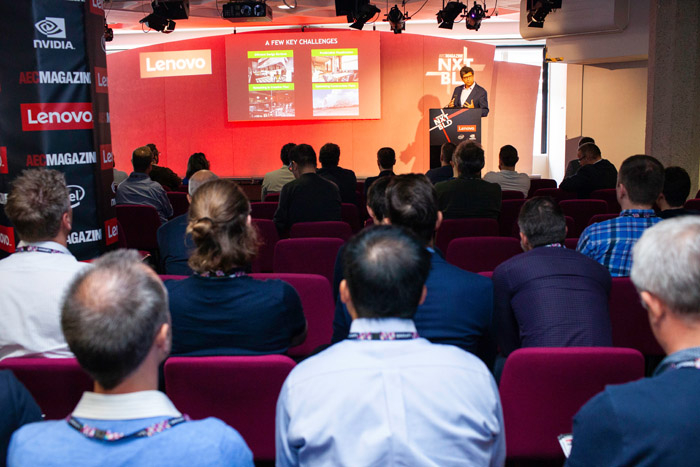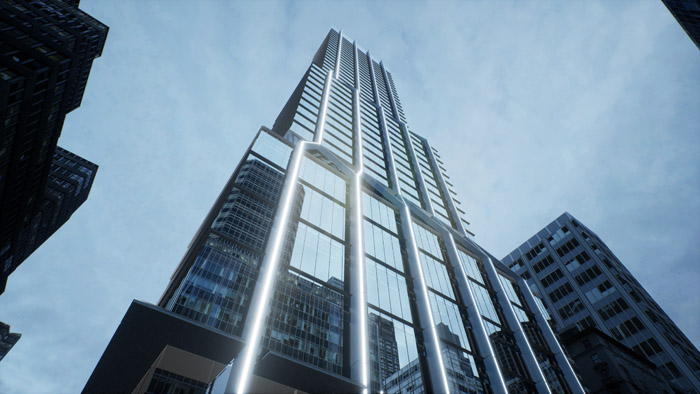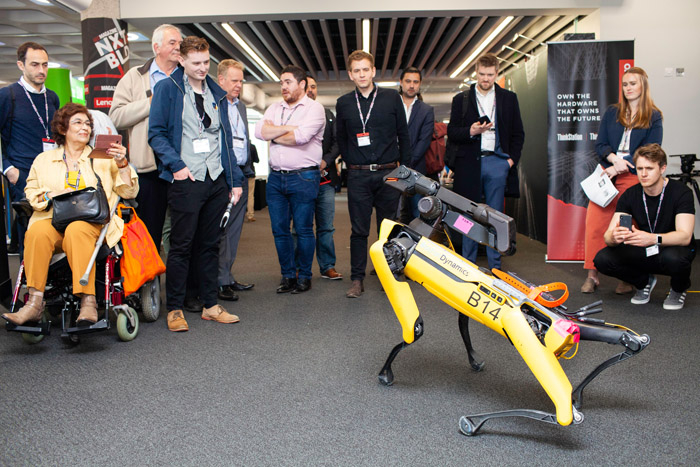Our 3rd annual exploration of the future of design and construction technology took place last month in London, examining a broad array of disruptive ideas and technologies that are set to have a huge impact on our industry
Over 17 years ago, AEC Magazine was our response to the potential of Building Information Modelling (BIM) to move the industry forward to 3D and a model-centric approach to defining buildings.
AEC Magazine’s sister publication, DEVELOP3D covers the manufacturing and product design sector, one that moved from 2D drawings to 3D models and digital fabrication twenty years ahead of the AEC industry.
With BIM-capable tools commonly owned by AEC firms (although not necessarily deployed in an exemplary BIM process) AEC Magazine is now examining the next set of technologies and processes which will disrupt our industry. The key topic areas include robotics, digital fabrication, offsite production, modular approaches to design, robots, artificial intelligence (AI), augmented / virtual reality (AR/VR), real-time photorealism and computational design.
On the evening before NXT BLD 2019, I sat down to write my introduction to the conference. I was going to open by making some predictions as to what will happen in the future of the AEC industry, then realised that the speakers that would come directly after me were already delivering those things – robots, automated production of buildings, etc. In Nostradamus comparisons, being able to see five minutes into the future didn’t seem like much of a vision to boast about!
The robots are here
Our keynote talk came from Boston Dynamics, who had flown over especially for the event, bringing two four-legged Spot Mini robots with them.
Boston Dynamics sees its roving robot as a sentinel for on-site construction and is about to launch its first commercial product into the construction space. The robot can work autonomously or be operated by remote control. Hopefully you’ve all seen videos online of Spot Mini walking around construction sites and even dancing to uptown funk!
Nothing really prepares you for the first time you meet Spot. It truly is an incredible piece of hardware. Michael Perry from Boston Dynamics was only 10 minutes into his presentation when Spot walked into the auditorium, up the stairs and on to stage. At that point the entire audience had their phones out to video this incredible work of engineering art.
The articulated arm on top of the robot, features a grabber and a camera, and the body behind has plenty of space to mount sensor devices. In fact, while at the show, Faro and Topcon took full advantage of access to Spot Mini to do some live tests in the exhibition area, where we had the first laser scans executed on specially designed 3D printed mounts. We’re convinced that Spot Mini will be a big hit in the world of reality capture, enabling the automated collection of scanned data for surveying and 4D analysis.
Melike Altınısık is a fantastic architect who creates beautiful flowing designs and runs her own practice, MAA, in Istanbul. Formerly at Zaha Hadid Architects, you can really see the influence in the curved and innovative forms which is typical of the work which MAA produces. A keen user of advanced technology, AltınıÐık has been innovating in her approach to construction and assembly.
Her work came to our attention when she won the Seoul Robot Science Museum competition and has designed a building for robots, to be assembled by robots. Another of MAA’s iconic projects will be visible from everywhere on Istanbul’s skyline, the futuristic 369m metre-tall telecommunication tower, which utilised revolutionary construction methodology.
Visual edge
Just prior to NXT BLD, Epic Games announced that it had acquired TwinMotion (which is powered by Unreal Engine) and that it would be giving the architect friendly real-time viz tool away for free until November (ArchiCAD customers get even a better deal).
Epic Games’ Ken Pimentel talked on this and how the development work in the popular video game Fortnite is driving the development of Unreal, for it to handle city-scale models and collaborative technologies. Unreal does offer one of the most realistic shaders out there and we are edging ever closer to their promise of real-time photorealism which will totally change the architectural visualisation market. Ken’s presentation gave delegates a great taste of what to expect in our dedicated viz and VR stream which ran in parallel to the main stage.

Advanced fabrication
Just weeks prior to the event I came across a fascinating article on a designer who had come up with a way of folding metal for construction by using origami techniques. After a brief conversation, Tal Friedman was initially just going to give a short 10 minute demo of his technology but we were fortunate to be able to give him a full 20 minute slot where he looked at generative building optimisation, complex façade design and these incredible self-standing and optimised origami metal forms.
Extra-terrestrial architects
Xavier De Kestelier of Hassell made the case for the practice of architectural design in the design of a future Mars-based habitat. Looking at utilising technologies such as robots and 3D printing, the design team came up with a whole process of a flock of robots constructing a 3D printed dome, from Martian soil. The idea is that the dome will shield an inflatable habitat from cosmic radiation, which gets through the atmosphere due to the weak magnetic field of Mars. This presentation really was a tour de force in architectural design story telling.
The new Bauhaus
ETH Zurich is the Bauhaus of the 21st Century. The University is incredibly well funded and has a laser focus on experimenting with digital fabrication and innovative ways to make buildings.
Last year we had Stefana Parascho and Andrei Jipa talking robots and concrete. This year Mariana Popescu of the Block Research Group talked about her revolutionary approach to using knitted forms to create in-place formwork for concrete. This new process, called Knitcrete, combines digital fabrication, computation and structural design with one of mankind’s oldest fabric creation processes. Popescu gave deep insight into the CNC knitting technique, its capabilities and a project completed with Zaha Hadid Architects at Museo Universitario Arte Contemporáneo (MUAC) in Mexico City.
Design inside VR
At our first ever NXT BLD, we had a young architect from Holland called Johan Hanegraaf from Mecanoo Architects, who presented the work he’d done in the evenings programming a Unity-based VR environment. This was for architectural modelling inside VR, as opposed to using VR as a just a viewing tool.
Now two years later he has teamed up with Icelandic developer and entrepreneur Hilmar Gunnarsson and at NXT BLD we got an exclusive viewing of Arkio, a new VR tool for architects specifically designed to support collaborative modelling. It runs on a desktop or a tablet and you just need one of the new low-cost headsets to get going in VR. The demo was exhilarating and allowed two designers to simultaneously work on a single model, generating geometry at a building or city scale.

Digital fabrication
For the afternoon, we were graced with Richard Harpham from Katerra, a US firm widely tipped to become the ‘Tesla’ of building companies. Starting at zero, within four years the company is now worth many billions, employs thousands and has an order book like no other house builder.
Katerra is driven to use digital fabrication methodology to produce buildings as components, shipped to site and is leading the charge in CLT (Cross Laminated Timber) buildings in countries that are adopting this material. Katerra has a range of configurable buildings, from apartments to eight storey office blocks which can be ordered online and delivered. London South Bank University is host to DARLAB, an advanced architectural fabrication research institute, headed up by Federico Rossi, that explores both subtractive and additive processes, combined with large-scale industrial robots. The project work of students and academics was shown at its full force through Rossi’s varied presentation. The algorithmic statue work for the World Wide Expo which went on for three months non-stop was incredible.
Florian Frank works at international architectural practice Herzog & De Meuron in the Digital Technology (DT) department, which develops and investigates new creative software tools and processes for CNC, visualisation, VR, BIM, Rhino/Revit/CAD and coding, providing solutions for the architectural groups.
Frank gave us practical examples as to how the DT group supports design 3D model development and we saw how physical models still play an important role within all the design teams. As he is a natural experimenter, he developed a 5-axis parametric environment in Grasshopper to generate milling strategies to bypass the old unintuitive CNC software to make fabrication less stressful.
Our final speaker was a special guest who literally flew in from New York for the day. Marc Fornes and his practice ‘THEVERYMANY’ have been using computational design and digital fabrication to make extremely thin, complex, self-supporting forms. The design team appears to be constantly experimenting with form generation, pushing the limits of the current technology while creating their own vocabulary and design aesthetic. A must see for all geometry explorers!
Conclusion
For those that missed the event, I think you get the gist that there was an amazing array of inspirational presentations. For an industry that is much maligned for being technologically backward, or lacking investment in technology, NXT BLD proves that this is no longer the case. In many respects, the level of investment and experimentation has become infectious, with many firms now evaluating digital fabrication and off site workflows. While generating complex forms and using the new methods of production may seem highly risky, the use of computational methods helps minimise that risk and even improve the quality. In many ways, while SketchUp and BIM adjusted the course from 2D to 3D modelling, the key deliverable is still a set of 2D drawings. The next step for the industry will be to embrace digital fabrication as the core output. You can rely on NXT BLD 2020 (London, 9 June 2020) to bring you the best of these early adopters and the latest in research.
Real-time ray tracing comes of age on the design viz and VR stage
In less than a year Nvidia RTX has gone from a demonstration technology to one that is being used to great benefit on real-life projects. NXT BLD’s dedicated design viz and VR conference stream provided the perfect platform for digital artists and architects to share their experiences of real-time ray tracing and for the technology developers to give a sneak preview of where things are headed in the future.
<
Carlos Cristerna of US marketing agency Neoscape dived straight in with a live demonstration of real-time ray tracing in Unreal Engine. Cristerna showed how the technology was currently being pushed to the limits on a live New York skyscraper project that had originally been configured for offline rendering, creating stills and animations with 3ds Max and V-Ray.

Doing a live demo comes with its risks but Cristerna perfectly illustrated just how fast an RTX-enabled viz workflow can be, toggling on reflections, refractions and global illumination on the fly with near instant results. Equally impressive was the fact that he was doing everything on a mobile workstation. The real time ray tracing demos that we have seen in the past have been multi GPU on powerful desktop workstations. Cristerna was using a 15-inch mobile workstation, Lenovo’s ThinkPad P53 with Quadro RTX 5000 graphics, which we review here.
“In a matter of minutes, you can do as many renderings as you want. If you have a presentation for a very important client tomorrow, you can put together a pretty decent presentation,” he said.
Cobus Bothma, applied research director at Kohn Pedersen Fox (KPF), gave an architect’s view of rapid visualisation and how it is being used to accelerate design decisions. “We don’t have a specialised visualisation team inside our office. There’s no one to go to, to say ‘can you render this stuff for us,” he said. “We train our designers to render, to compute, to use BIM etc… they all get involved in communicating their design and visualisation.”
Bothma’s presentation gave a fascinating insight into KPF’s visual design process using a broad set of tools including V-Ray (Project Lavina), Enscape, Unreal Engine and Nvidia Holodeck. This wasn’t about generating glossy marketing images; it was about using visualisation for communication and to influence the design process.
Bothma explained that it’s the workflow that leads up to render process that is most important; the rendering takes care of itself through hardware and software. For the biggest scenes, he explained, these can be pushed down to clusters or bigger scale GPU machines, so precious time doesn’t have to be spent optimising models.
Bothma made the very important point that in design, real-time is relative. “We don’t need to run 11ms a frame, we can actually wait a little bit for it. If we wait half a second, it’s OK. If we run ten frames a second, it’s also OK. It’s about communicating exactly what you need to communicate at the right time.”
Nvidia launched RTX last year but it’s taken a while for the technology to appear in commercial applications. Much of the focus has been on Epic Games and Unreal Engine but Enscape and Chaos Group, which have a longer history in the AEC sector, are set to bring their ‘real-time’ ray tracing, RTX-enabled applications to market soon. Presentations from both firms gave NXT BLD delegates a chance to see where things are heading.
Moritz Luck, co-founder of Enscape showed how RTX technology is currently being implemented into its push button viz tool. Architects love Enscape because it is so easy to use. In a live demo, Luck showed how this ethos will continue with the RTX-enabled version of Enscape, by enhancing the visual quality of a complex scene at the push of a button with near instant ray tracing.
Simeon Balabanov from Chaos Group showed the latest developments in V-Ray for Unreal – specifically, how users of the popular photorealistic arch viz renderer can harness their V-Ray workflow for the real time engine, or simply get high-quality ray traced imagery out of Unreal. Balabanov also gave a glimpse of Project Lavina, its new ray traced rendering engine for real time previews that takes advantage of Nvidia RTX GPUs and their ray tracing cores.
If delegates were left wondering what the magic was behind these advanced viz workflows, Nvidia’s Sandeep Gupte had the answers. As part of a broad presentation on the expanding role of GPUs in the AEC sector, Gupte explained how RTX works and the technology behind its new Quadro RTX GPUs. He also gave a glimpse into the future of collaborative VR through the impressive Nvidia Holodeck.
Lenovo’s Mike Leach also showed how RTX technology has now made its way into mobile workstations as well as giving an excellent overview of Virtual and Augmented Reality and the many options available to AEC firms. The Oculus Rift and HTC Vive might get most attention but there are several other powerful options for architectural VR.
Herzog De Meuron’s VR lead Mikolaj Bazaczek continued the VR discussion with a fascinating insight into the Swiss architecture firm’s VR journey and workflow, w hile Nassim Saoud of Trimble Consulting turned the discussion to Mixed Reality and its growing influence in the AEC sector.
Finally, Alexander Le Bell, CEO of Finnish firm Tridify closed proceedings by introducing a new technology designed to make BIM model data instantly available to anyone, everywhere in VR or on mobile phones.
Greg Corke
Watch NXT BLD 2019 on demand
Missed a talk or would like to see a favourite again? The good news is you can now watch all of the presentations from NXT BLD 2019 (and our 2017 and 2018 events) on AEC Magazine’s YouTube channel.
Save the date NXT BLD 2020

NXT BLD 2020 will take place at the Queen Elizabeth II Centre in London on 9 June 2020. More info at nxtbld.com over the coming months
If you enjoyed this article, subscribe to our email newsletter or print / PDF magazine for FREE







